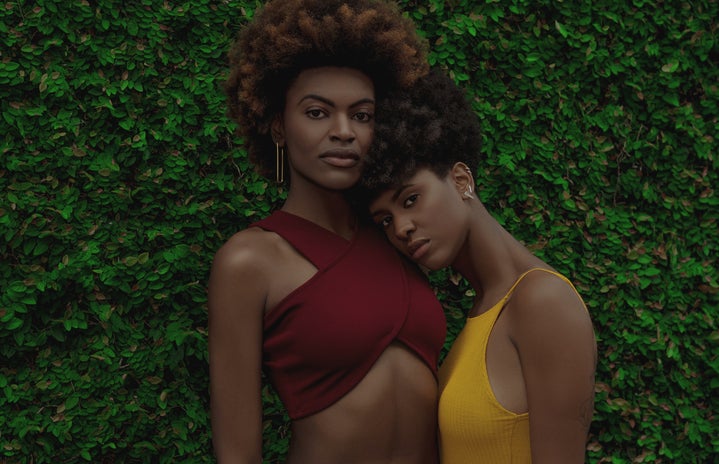It’s not a surprise that the educational curriculum throughout America is severely white-washed, especially in the studies of history. This means that without doing our own research growing up, many kids have not been acquainted with prominent black figures that impacted all fields ranging from science and medicine to the music and arts, to politics and social justice. Here are a few key figures we should keep in mind when thinking about black history this Black History Month:
-
The Ella Baker Center for Human Rights works to fight against the problems associated with today’s mass incarceration, as well as strengthen low-income communities. It’s named after Ella Baker, who was a major leader of the Civil Rights Movement, notably during the 1950’s and ‘60s. Prior to that, she served as the national director of the Young Negroes Cooperative League (YNCL), which strived for economic equality for black people living in America during the ‘30s. In the ‘40s, she began working for the National Association for the Advancement of Colored People (NAACP), where she raised funds and recruited members. She went on to become the NAACP’s national director of branches in 1943, and the director of the New York chapter of the NAACP in 1952. A few years later, Baker worked with Dr. King Jr. to launch the Southern Christian Leadership Conference (SCLC)—where she apparently clashed with him and other men, who weren’t used to working alongside headstrong women. She helped organize the creation of the Student Non-Violent Coordinating Committee (SNCC), which she remained a part of for many years. She helped them create the Mississippi Freedom Democratic Party (MFDP) to combat the state’s democratic party, which upheld segregationist views. Although her work isn’t as widely acknowledged, her fundamental work through different organizations and events lives on forever through her human rights center today.
-
Gwendolyn Brooks was the first African American poet to win the Pulitzer Prize. She won the prize for a series of poems she wrote, called “Annie Allen”, which reflected on an African American girl’s experience growing up in Chicago. A lot of her work, which included poetry, sonnets, ballads, and books, revolved around the everyday life of urban black people, although many themes were universal to the general human experience. Throughout her career, she was Poet Laureate for Illinois, Consultant in Poetry to the Library of Congress, and taught at different universities. She’s recognized for her ability to lyricize the black American experience, as well as spread tolerance. Some of her most works of art include “The Children of the Poor”, and “We Real Cool”.
-
Shirley Chisholm was the first black congresswoman and the first major-party black candidate to run for the presidency. She was born in a primarily black neighborhood, in Brooklyn, New York. She worked as an educational consultant at the beginning of her career, at different child care centers. In 1968, she made history when she became the first African American congresswoman, which she served for seven terms. She was initially assigned to the House Forestry Committee, but she demanded reassignment, and eventually graduated to the Education and Labor Committee. In 1969, she was one of the founding members of the Congressional Black Caucus, where she promoted education and employment opportunities for minorities in the U.S. In 1972, she made history again, by becoming the first major-party African American candidate (and second woman ever) to make a bid for the presidency, when she ran for the Democratic nomination. Despite Chisholm’s passionate campaigns, Senator George McGovern claimed the nomination. Aside from her historic work in congress, she was an early member of the National Organization for Women (NOW), and was active in the NAACP. In 1993, she was included in the National Women’s Hall of Fame.
-
Just nine months before Rosa Parks refused to give her seat on the bus to a white passenger in 1955, Claudette Colvin did the same thing. On March 2nd of the same year, a bus driver demanded 15-year old Colvin to give up her seat to another passenger. Colvin refused, claiming she’d paid her fare, and that it was her constitutional right. Speaking on the incident years later, Colvin said that it occurred during Negro History Month, which she was studying in school at the time. She was learning about several activists and black leaders, from Harriet Tubman to Sojourner Truth. She said, “My head was just too full of black history, you know, the oppression that we went through. It felt like Sojourner Truth was on one side pushing me down, and Harriet Tubman was on the other side of me pushing me down. I couldn’t get up”. Despite her and Parks both taking strong roles in the bus boycotts at the time, many don’t know Colvin’s story. Colvin claimed that the NAACP and other black organizations felt Parks would be a better icon for the face of bus boycotts because she was an adult, and could be seen as more reliable than a teenager. In addition, Parks had the “right hair” and the “right look”—referencing her lighter skin complexion. Colvin was similar to the majority of people in the movement: young women and men who weren’t credited for their efforts. However, both of these women’s stories were belittled through history, as we weren’t taught about Park’s life-long work as an activist, or about Colvin at all.
-
Prior to the 2014 release of the award-winning film Selma, Annie Lee Cooper was not as widely known for her role as a civil rights hero. She spent a majority of her life in Kentucky with her sister, but returned to her hometown Selma, Alabama, as her mother’s health declined. By this time, she was 52 years old, and she realized she wouldn’t be allowed to register to vote in Alabama. This prompted her participation in the Civil Rights Movement, and involvement with the SNCC, which got her fired from her job as a nurse. Three years later, she attempted voter registration again at the Dallas County Courthouse, where she encountered sheriff Jim Clark, who was pro-segregation. He told her to leave, and when she refused, he struck her with a metal baton. In response, she punched him right in the jaw. She was further beaten by other officers and was then charged with criminal provocation and attempted murder. When Dr. King Kr. heard of her situation, he referenced her in one of his speeches, propelling the voting right’s movement forward. Her actions led to the passing of the Voting Rights Act of 1965.
-
Dorothy Height was a Civil Rights activist primarily focused on fighting for the opportunities and rights of African American women. She was honored with the Presidential Medal of Freedom in 1994, and the Congressional Gold Medal in 2004. She began getting politically active in high school, where she participated in anti-lynching campaigns. After high school, she’d been admitted to Barnard College, though they later reversed their decision, claiming they’d already reached their quota for black students. In 1937, Height was working at the Harlem YWCA, where she met the founder of the National Council of Negro Women (NCNW), Mary McLeod Bethune, and soon began volunteering for the organization. At the YWCA, she pushed for the integration of all its centers—and achieved it—by 1946. There she also established a Center for Racial Justice. Between the two, she quickly became one of the leading figures of the civil rights movement. In 1963, she helped organize the March on Washington, where Dr. King Jr. delivered his iconic “I have a dream” speech. Height, despite her leadership skills and involvement, was not asked to speak that day. She later stated that the March on Washington opened her eyes to the reality of her male counterparts, whom she said were “happy to include women in the human family, but there was no question as to who headed the household”. She promptly began fighting for women’s rights. In 1971, she founded the National Women’s Political Caucus alongside Gloria Steinem, Betty Friedan, and Shirley Chisholm. She began focusing on the empowerment of African American families during her time working with the NCNW, and later organized the first Black Family Reunion in ‘86. Barack Obama went on to call her the “godmother of the civil rights movement”.
-
Marsha P. Johnson was an LGBTQ+ rights activist who especially advocated for trans people of color. Marsha experienced a lot of difficulties being raised in a Christian household as a trans woman. She moved to New York after high school, where she was homeless and turned to prostitution herself to make ends meet. She quickly became a prominent face in the LGBTQ+ community when she began performing as a drag queen and helping struggling LGBTQ+ youth in the city. She expressed her boldness through her magnificent costumes and jewelry as a drag queen, which is where she found herself. She claimed that the “P” in her name stood for “Pay it No Mind”, which referenced her gender and sexuality—which she strongly stated was nobody’s business. She was later known to have instigated the Stonewall Riots, where the LGBTQ+ community began protesting the police following the random, targeted, public arrests of several LGBTQ+ individuals outside a prominent gay hub: the Stonewall Inn. Throughout her career as an activist, she was overlooked due to her identity as a trans-black woman; especially as white people began overtaking the gay and lesbian movement. She went on to co-found the Street Transvestite Action Revolutionaries (STAR), which was committed to helping struggling transgender youth. STAR provided services including shelter and food for people in New York City, Chicago, California, and England in the early ‘70s. Unfortunately, at the age of 46, her body was found in the Hudson River. The police ruled it a suicide, but her case was re-opened 25 years later. In 2015, the Marsha P. Johnson Institute was established, which promotes the human rights of transgender and gender-nonconforming communities.
-
Henrietta Lacks was an ordinary mother of five, who visited the John Hopkins Hospital following instances of peculiar vaginal bleeding. At the time, this hospital was one of the few that tended to the needs of lower-income black Americans. Gynecologist Howard Jones found that Lacks had cervical cancer, and she began receiving radium treatments. A sample of her cancer cells was sent to the labs of Dr. George Gey, who was collecting cervical cancer cell samples to research viruses and cancers. However, all previous cell samples had died in his lab within a short amount of time. Unlike them, Lack’s cells were doubling every 24 hours. Today, these cells are called the “HeLa” cells in her honor. They’re used to study the effects of toxins, hormones, viruses, and drugs on the growth of cancer cells—without having to experiment on humans. They were used to test the effects of radiation and poison, to study the overall human genome, to learn more about viruses, and they played a central role in the development of the polio vaccine. Although Lacks passed away at the age of 31, in 1951, her cells continue to impact the medical world today.
-
Gordon Parks became the first African American photographer for Life and Vogue magazines, even being a self-taught artist. As a child, he attended a segregated elementary school and was excluded from activities in high school due to his race. His teachers discouraged black students from pursuing higher education. He began taking on random jobs at the age of 14 when his mother passed away. At the age of 25, he saw photographs of migrant workers in a magazine and decided to start photography. His career started with portraits and fashion photographs. However, he progressed into photographing the low-income black neighborhoods of South Side Chicago. He went on setting trends while working for Vogue and Life magazine, where he produced artworks of sports, entertainment, fashion, along with poverty and segregation. In addition, he photographed African American leaders like Muhammad Ali and Malcolm X. In ‘69, he became the first black American to direct a major Hollywood film, which was the film adaptation of his autobiography, “The Learning Tree”. His later film “Shaft”, became a hit in 1971. Today, he’s remembered for his pioneering work in photography.
-
Bayard Rustin was a prominent Civil Rights activist in the ‘50s and ‘60s and is widely noted for his work as an advisor to Dr. King Jr. In the 1930’s, he was involved with the Young Communist League, though he resigned quickly after. His philosophies were based on the pacifism from the Quaker religion, the non-violence from Mahatma Gandhi’s teachings, and the socialism taught by African American labor leader A. Phillip Randolph. During WW2, he worked under Randolph to combat racial discrimination in war-related employment. He further participated in pacifist groups, including the Fellowship of Reconciliation. During the war, he was arrested for refusing to be drafted. Furthermore, when protesting the segregation of the public transit system in North Carolina in 1947, he was sentenced and charged to work on a chain gang for weeks. A few years later, he was arrested for publicly engaging in homosexual activity—but he continued to live as an openly gay man. By the ‘50s, he became a major organizer of human rights protests. In 1958, he coordinated a march in Aldermaston, England, where over 10,000 participants fought against the use of nuclear weapons. He began working with Dr. King Jr. as an organizer and strategist in 1955. He taught King about Gandhi’s teachings of non-violence, and about the tactics of civil disobedience. He was a key figure in the organization of the March on Washington, and also helped with the bus boycotts in Alabama. He continued to advocate for economic equality within the Civil Rights and peace movements, and for the social rights of the LGBTQ+ community.



